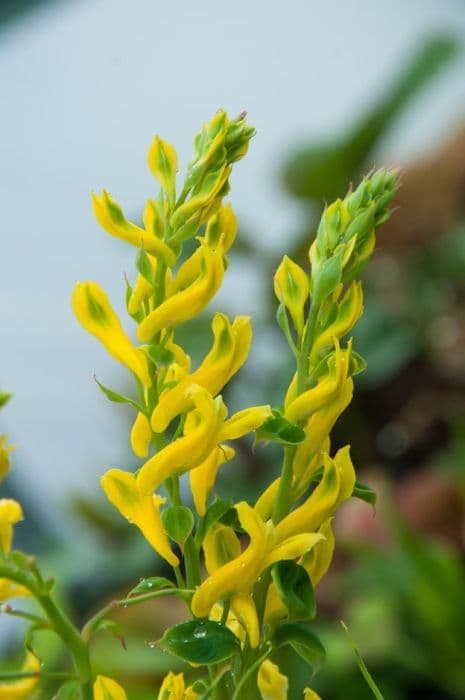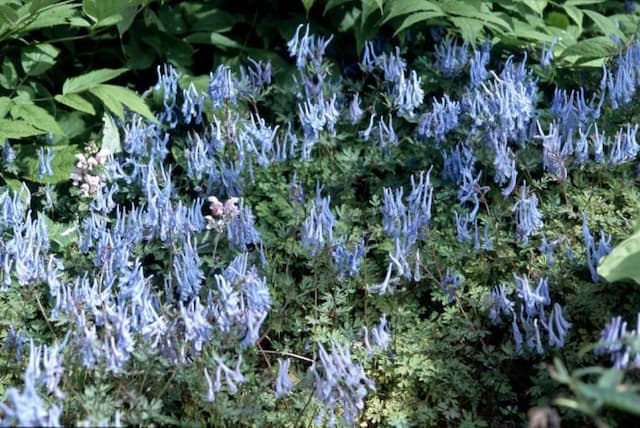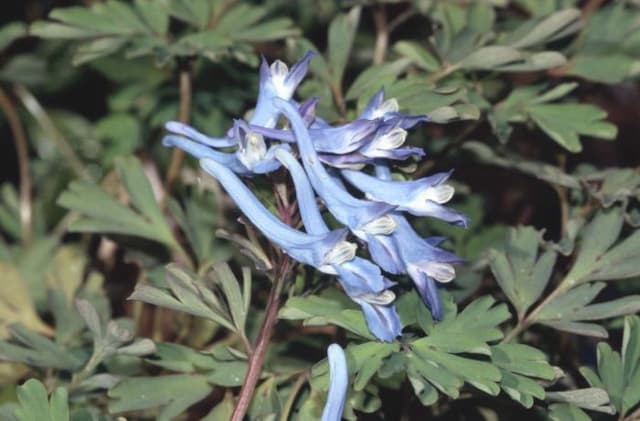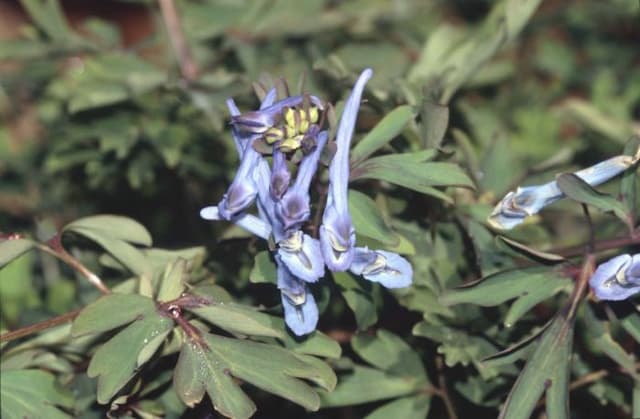Not available. Corydalis 'Tory MP'

ABOUT
The Corydalis 'Tory MP' is a plant characterized by its delicate foliage and attractive tubular flowers. The foliage often has a lacy or fern-like appearance, presenting a soft texture in the garden. The leaves are usually a bluish-green or grayish hue, though the exact color can vary. This gentle foliage contrasts with the vibrant blooms that emerge above it. The flowers are the most striking feature of the Corydalis 'Tory MP', with a captivating range of colors. They commonly boast shades of blue, purple, or lavender, with some varieties displaying bicolored petals. Each bloom typically has a spur at the back, which gives it a unique, elongated shape reminiscent of old-fashioned smoking pipes. The blossoms are arranged in racemes, creating an elongated cluster along the stem, which makes them quite eye-catching when they sway gently in the breeze. This plant is known for its beauty in shady garden spots, where the combination of its elegant leaves and vivid flowers can really shine. It's also worth noting that the plant's charming appearance can attract pollinators, such as bees and butterflies, adding movement and an extra layer of life to the space it occupies.
About this plant
 Names
NamesFamily
Papaveraceae
Synonyms
Fumewort
Common names
Corydalis 'Tory MP'.
 Toxicity
ToxicityTo humans
Corydalis, including the variety 'Tory MP', may contain alkaloids that can be toxic to humans if consumed in significant amounts. If ingested, these alkaloids can potentially cause symptoms such as nausea, dizziness, and fatigue. Long-term or high-dose ingestion could lead to more serious effects, including organ damage. It is essential to handle the plant with care and ensure that it is not ingested, especially by children, who are more susceptible to the toxic effects.
To pets
Corydalis can also be toxic to pets if consumed. The alkaloids present in the plant can cause symptoms in animals similar to those seen in humans, such as vomiting, diarrhea, lethargy, and potentially tremors. In severe cases, ingestion could lead to more serious health issues, including organ damage. Pet owners should prevent their pets from ingesting any part of the plant and seek veterinary care if accidental ingestion is suspected.
 Characteristics
CharacteristicsLife cycle
Perennials
Foliage type
Deciduous
Color of leaves
Green
Flower color
Varies
Height
0.5-2 feet (15-60 cm)
Spread
0.5-1 feet (15-30 cm)
Plant type
Bulb
Hardiness zones
5
Native area
Europe
Benefits
 General Benefits
General Benefits- Ornamental Value: Adds visual appeal to the garden with its attractive foliage and flowers.
- Habitat for Wildlife: Provides food and shelter for insects such as bees and butterflies.
- Low Maintenance: Requires minimal care once established, which is great for busy gardeners.
- Drought Tolerance: Can survive in drier conditions, making it suitable for xeriscaping.
- Shade Tolerance: Thrives in partially shaded areas where other plants may not grow as well.
- Seasonal Interest: Offers a range of seasonal colors and textures throughout the year.
 Medical Properties
Medical PropertiesI'm sorry, but there is no available information on a plant named Corydalis 'Tory MP' with recognized medical uses as of my last knowledge update in March 2023. This plant may either not exist under this name or it is not used for medical purposes. If this plant exists under a different common name and has medical properties, the information might not have been available or disclosed as of my current knowledge. It's important to consult reliable sources or professionals for information on medicinal plants and their uses.
 Air-purifying Qualities
Air-purifying QualitiesThis plant is not specifically known for air purifying qualities.
 Other Uses
Other Uses- Corydalis can be used as a natural dye, providing a range of colors from yellow to green depending on the part of the plant used.
- The plant's foliage can offer a habitat and food source for caterpillars and other beneficial insects.
- Corydalis may be used as a component in compost or green manure due to its ability to break down and enrich the soil.
- Some gardeners might plant Corydalis simply for the beauty of its blooms to enhance a rock garden or woodland border, where it can thrive in the dappled light underneath trees.
- The plant can be used in floral arrangements to add a delicate touch to bouquets, particularly informal or 'wild' flower designs.
- Corydalis can act as ground cover in shaded garden areas, helping to prevent soil erosion with its foliage.
- The seeds of Corydalis are considered attractive to ants, which may help with seed dispersal, promoting the plant's spread in the garden ecosystem.
- In a sensory garden, Corydalis' soft texture and gentle swaying can provide a calming visual effect.
- When used in a garden designed for night viewing, the light-colored flowers of some Corydalis can add brightness and visibility in the moonlight.
- The plant can serve as an indicator species in the garden; its health may reflect specific soil conditions or indicate when a particular microclimate matches its growing preferences.
Interesting Facts
 Feng Shui
Feng ShuiThe plant Corydalis is not used in Feng Shui practice.
 Zodiac Sign Compitability
Zodiac Sign CompitabilityThe plant Corydalis is not used in astrology practice.
 Plant Symbolism
Plant Symbolism- Hope: Corydalis, with its delicate flowers, often symbolizes hope, representing a steadfast belief in the possibility of better times ahead.
- Tranquility: The gentle appearance of Corydalis flowers signifies peace and tranquility, suggesting a calming influence in one's life.
- Joy: The bright blossoms of Corydalis are commonly associated with joy and cheerfulness, bringing a light-hearted vibe to gardens and homes.
 Water
WaterCorydalis, commonly known as Fumewort, prefers evenly moist soil and requires regular watering, especially during dry spells. Aim to water them with about 1 inch of water per week, adjusting as necessary during particularly hot or dry weather. It is best to check the top inch of soil for dryness and water when it feels dry to the touch. Water at the base of the plant to avoid wetting the foliage, which can lead to fungal diseases. During the winter months or dormant periods, reduce watering to prevent root rot.
 Light
LightFumewort thrives in partial shade to full shade conditions. It is well-suited for spots that receive filtered light or morning sun followed by afternoon shade. Avoid placing it in full sun, especially in hotter climates, as this can scorch the delicate foliage. An ideal location would be under the canopy of larger trees or on the north side of a building where it receives bright but indirect light.
 Temperature
TemperatureFumewort performs best in a temperature range of 50°F to 75°F and can tolerate a minimum temperature down to 20°F. The ideal growing conditions are cool, avoiding extremes in temperature, as excessively high temperatures may cause the plant to go dormant early. Ensure protection from harsh winter winds by positioning in a sheltered location or applying mulch to insulate the roots.
 Pruning
PruningPruning of Fumewort is mainly to remove spent flowers and any yellowing or dead foliage, which promotes healthy growth and prevents disease. Light pruning can be done after flowering to maintain the plant's shape and encourage a second bloom in the fall. The best time for more significant pruning is in late winter or early spring before new growth starts.
 Cleaning
CleaningAs needed
 Soil
SoilThe best soil mix for Fumewort (common name of Corydalis 'Tory MP') is a well-draining mix with high organic content. A blend of loam, peat, and sand in equal parts is ideal. Adjust the soil pH to be slightly acidic to neutral, ranging from 6.0 to 7.0 for optimal growth.
 Repotting
RepottingFumewort should be repotted every 1-2 years or when it has outgrown its current container. The best time to repot is in the spring, just as the plant resumes active growth.
 Humidity & Misting
Humidity & MistingFumewort prefers moderate humidity levels. Aim to maintain the humidity around 30-50% for ideal growing conditions. Avoid placing the plant in excessively dry environments.
 Suitable locations
Suitable locationsIndoor
Place Fumewort in bright, indirect light with proper soil mix.
Outdoor
Plant Fumewort in partial shade, shield from harsh sun.
Hardiness zone
5-9 USDA
 Life cycle
Life cycleThe "Corydalis 'Tory MP'", likely a fictional or colloquial name as it does not correspond to a recognized botanical name, would hypothetically follow a life cycle similar to other Corydalis species. Initially, the plant begins as a seed that requires a period of cold stratification to break its dormancy. Upon sprouting, the plant grows into a seedling, featuring its first set of true leaves as it matures gradually. Following the vegetative stage, it develops into a mature plant with a full set of leaves and begins its reproductive phase, where it produces distinct flowers, often tubular or spurred, assuming it receives adequate sunlight and nutrients. After pollination, typically by insects, it sets seed, which are then dispersed by various means, including wind or animals. Once its life cycle is complete, usually at the end of the growing season, the plant may die back, especially if it is an annual or herbaceous perennial, with seeds overwintering until conditions are right for the next generation to begin the cycle anew.
 Propogation
PropogationPropogation time
Spring to Summer
Propogation: The most popular method of propagating Corydalis 'Tory MP', typically known just as Corydalis, is by division. This process is best done in the autumn when the plant has finished flowering and has started to go dormant. To propagate by division, carefully dig up the entire clump and gently separate the roots into smaller clumps, making sure that each new piece has at least one growth bud. These divisions can then be replanted immediately in well-draining soil at the same depth they were growing before. Water the newly planted divisions lightly to settle the soil around the roots. Over the next few weeks, keep the soil consistently moist but not waterlogged to encourage the development of new root systems. This straightforward method ensures that the characteristics of the parent plant are retained in the new plants.









